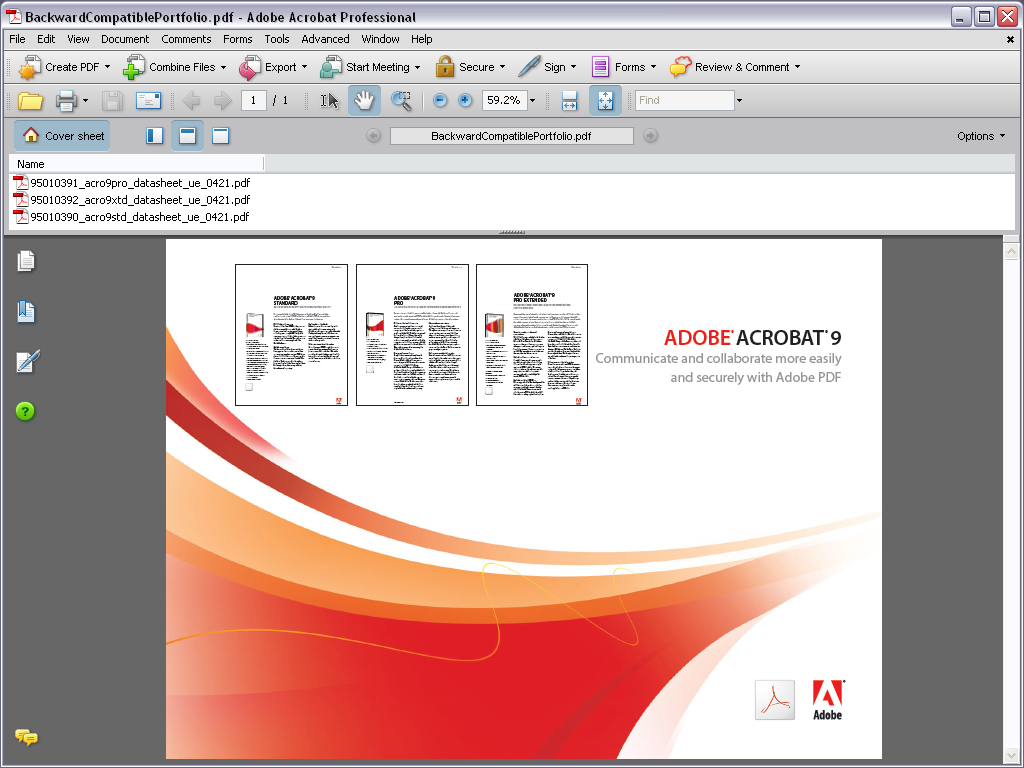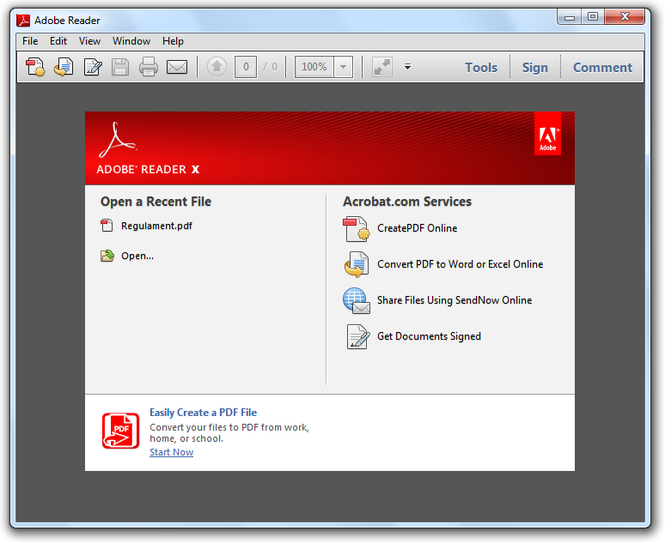Adobe Acrobat Pro for Mac offers the wonderful functionality of Adobe Reader as well as some extra features, allowing you to combine PDFs into one file, create fillable forms, edit existing PDFs. Adobe Acrobat Pro for Mac offers the wonderful functionality of Adobe Reader as well as some extra features, allowing you to combine PDFs into one file, create fillable forms, edit existing PDFs.
Windows users: If you are on a Windows computer, see Install Adobe Acrobat Reader DC | Windows.
Installing Adobe Acrobat Reader DC is a two-step process. First you download the installation package, and then you install Acrobat Reader DC from that package file. You do not have to remove the older version of Reader before installing Acrobat Reader DC.
Before you install, always make sure that your system meets the minimum system requirements.
You need Mac OS X 10.9 or later to run Acrobat Reader DC. If your operating system is older,
you can install an earlier version of Reader. For step-by-step instructions, see Install an older version of Adobe Reader on Mac OS.
Oct 31, 2011 If you want a quick PDF file to use for this tip, you can grab the Apple history book “The Macintosh Way” for free (direct PDF link), or just launch any other PDF file sitting around on your Mac.The speedy Preview app will now be the default app to open the PDF document. Click this link to browse to the program that you want to set as the default PDF reader, and choose the “Open” button to set it as the default. Changing the default PDF reader app in Windows is a simple procedure, and that’s all there is to it. In OS X, Apple’s Preview. Is the default application for opening a number of file types, including PDF’s. While versatile, Preview will NOT allow you to make changes to PDF’s with editable content. Follow these instructions to set Adobe Acrobat Reader as the default application for opening PDF files. https://luckywhole.netlify.app/default-reader-for-pdf-mac.html.
Note:
Not sure which version of Mac OS you have? Click the Apple icon in the upper-left corner of your screen, then choose About This Mac.
Go to the Adobe Acrobat Reader download page and click Install now.
Note:
You need Mac OS X 10.9 or later to run Acrobat Reader DC. If you're running Mac OS X 10.8 or older, the Adobe Reader download page looks like this:
You can install an older version of Acrobat Reader. For instructions, see Install an older version of Adobe Reader on Mac OS.
When asked whether to save the .dmg file, select Save File.
Adobe acrobat reader dc for windows 10. Note:
If you do not see this dialog box, another window could be blocking it. Try moving any other windows out of the way.
Free acrobat reader for mac 10.4.11. Adobe Acrobat Reader for Mac Versus Adobe Acrobat DC Adobe Acrobat DC is a complete PDF viewing and editing solution packed with best-in-class tools to satisfy all PDF needs. Whereas Adobe Acrobat Reader for Mac is aimed chiefly at the consumers of PDF files, Adobe Acrobat is aimed at the authors of PDF files. Watch video Adobe Reader proves to be the most functional, free PDF reader and editor available. Admittedly, Preview for Mac does share some of the features available on Adobe Reader, but not all. Installing Adobe Acrobat Reader DC is a two-step process. First you download the installation package, and then you install Acrobat Reader DC from that package file.
Double-click the .dmg file. (If you don't see the Downloads window, choose Tools > Downloads.)
Double-click Install Adobe Acrobat Reader DC to start the installation.
When asked if you are sure that you want to open the file, click Open.
When prompted, enter your macOS user name and password.
In case you do not remember your password, refer the Apple document: https://support.apple.com/en-in/HT202860When you see the confirmation message that the installation is complete, click Finish.
Go to the Adobe Acrobat Reader download page and click Install now.
Note:
You need Mac OS X 10.9 or later to run Acrobat Reader DC. If you're running Mac OS X 10.8 or older, the Adobe Reader download page looks like this:
You can install an older version of Acrobat Reader. For instructions, see Install an older version of Adobe Reader on Mac OS.
Double-click the .dmg file. (If you don't see the Safari Downloads window, click Finder > (User Name) > Downloads.)
Double-click Install Adobe Acrobat ReaderDC to start the installation.
When asked if you are sure that you want to open the file, click Open.
When prompted, enter your macOS
user name and password.
In case you do not remember your password, refer the Apple document: https://support.apple.com/en-in/HT202860When you see the confirmation message that the installation is complete, click Finish.

Go to the Adobe Acrobat Reader download page and click Install now.
Note:
You need Mac OS X 10.9 or later to run Acrobat Reader DC. If you're running Mac OS X 10.8 or older, the Adobe Reader download page looks like this:
You can install an older version of Acrobat Reader. For instructions, see Install an older version of Adobe Reader on Mac OS.
When the file appears at the bottom of the browser, click the file. (If you don't see the file, choose Downloads from the Chrome menu.)
Double-click Install Adobe Acrobat Reader DC to start the installation.
When asked if you are sure that you want to open the file, click Open.
When prompted, enter your macOS user name and password.
In case you do not remember your password, refer the Apple document: https://support.apple.com/en-in/HT202860.When you see the confirmation message that the installation is complete, click Finish.
To see if other users are experiencing similar download and installation problems, visit the Acrobat Reader user forum. Try posting your problem on the forums for interactive troubleshooting. When posting on forums, include your operating system and product version number.
More like this
Twitter™ and Facebook posts are not covered under the terms of Creative Commons.
Legal Notices | Online Privacy Policy
Intro
Editors' note: This review, originally based on the final beta, has been updated to reflect the final, release version of the program.
With the file formatting in Adobe Acrobat 7.0 Professional, your carefully written, thoughtfully presented, and beautifully illustrated presentation will come across in a Portable Document Format (PDF) file just as you intended it, no matter who reads it on what platform. And although some other software utilities now allow you to save or convert PDF documents and even let you do basic PDF work, Adobe's Acrobat line of products remains the premier option, with the latest productivity enhancements. The latest version adds new collaboration tools, organization, and other office-related features but at a price: system performance. Those with top-end PCs or Macs should have no trouble, but everyone else will notice some performance decrease with all the new bells and whistles within the Professional edition. Also available is the Standard version, which costs $200 less and sacrifices a few of the most workgroup-critical features but still provides the most essential functionality without as much of a performance hit. Adobe Acrobat 7.0 Professional is available for Windows 2000 and XP and Mac OS X. For Windows, simply download or start the installation from the CD. To get up and running with a Mac, drag the Acrobat 7.0 Professional folder (again, either as a download or from a CD), which contains Acrobat 7.0, Acrobat Distiller, and an uninstaller, to your Applications folder--no wizards or complex installation decisions required. The app comprises more than half a gigabyte, however, so copying the files can take a while on a computer with a slow hard drive.
The interface is unchanged from 6.0, with the exception of new toolbar buttons for Commenting and Markup, Send for Review, Security, Signature, and the single-button Create PDF option. There are also new tabs along the left side of the document window that allow you to access reader comments and file attachments.
Adobe Reader 7
 Adobe Acrobat 7.0 Professional introduces a host of good new features. Adobe also claims that newly generated PDF files result in smaller file sizes than with previous versions of Acrobat, which is true, allowing you to e-mail or post larger documents than you could before.
Adobe Acrobat 7.0 Professional introduces a host of good new features. Adobe also claims that newly generated PDF files result in smaller file sizes than with previous versions of Acrobat, which is true, allowing you to e-mail or post larger documents than you could before.Acrobat Reader For Mac Os
Tight integration with Microsoft Office 2003 allows you to convert most Word, PowerPoint, and Excel files within the applications themselves to PDFs. Acrobat 7.0 can also make PDFs of captured Web pages--but only in the Windows version. Mac users also miss out on the Windows version's capability to convert Outlook e-mail and Publisher, Visio, Access, and Project files, though this is because there are no Mac versions of those products. However, the Mac version shares with Windows PDF conversion for AutoCAD projects, complete with the ability to embed 3D objects.
Acrobat 7.0 Professional also gains security features, including custom password protection for PDF files; a thumbnail-based organizer; new commenting tools, such as virtual sticky notes; and the ability for users of the free Acrobat Reader 7.0 to review documents and add their own comments. Collected reader comments then appear in their own PDF document, which you can search and index later--handy for office collaboration on team projects.
Acrobat Reader 7 Download Free
Adobe offers a wide range of free support options for Acrobat 7.0 Professional on the company's Web site, including user forums, which often feature 'expert guest hosts' who pop in with answers, as well as links to user groups and FAQs. The various site options are fairly easy to navigate, as they are organized around product lines as well as specific issues or design topics.Adobe Reader 7 For Mac
Phone technical support is a roll of the dice, however; it might just be a free tech-support call, but you won't know until after you've placed the call. Installation and product-defect support is always free, but other problems may or may not carry a fee. When you call Adobe's technical support, you'll be asked for a credit card number first, and a support technician will determine whether your issue qualifies for free support after he or she listens to your complaint. If Adobe decides to charge you, the tech will ask whether you want to continue and quote you the expected costs associated with your call.